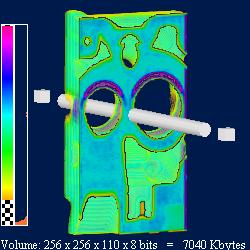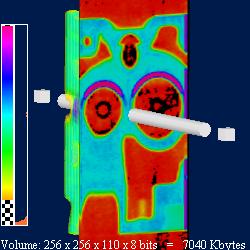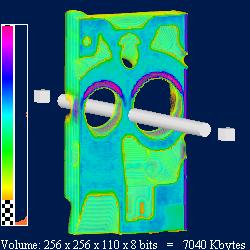 Ortho slice shape node.
More...
Ortho slice shape node.
More...
#include <VolumeViz/nodes/SoOrthoSlice.h>
 Inheritance diagram for SoOrthoSlice:
Inheritance diagram for SoOrthoSlice:Public Types | |
| enum | Axis { X , Y , Z } |
| Slice Axis (see discussion of medical data axes in the class description) More... | |
| enum | ClippingSide { FRONT , BACK } |
| Clipping Side mode. More... | |
 Public Types inherited from SoSlice Public Types inherited from SoSlice | |
| enum | AlphaUse { ALPHA_AS_IS , ALPHA_OPAQUE , ALPHA_BINARY } |
| Alpha component usage mode Used in the alphaUse field. More... | |
 Public Types inherited from SoVolumeShape Public Types inherited from SoVolumeShape | |
| enum | Interpolation { NEAREST , LINEAR , TRILINEAR , MULTISAMPLE_12 , CUBIC } |
| Interpolation mode. More... | |
| enum | Composition { MAX_INTENSITY = 0 , MIN_INTENSITY , SUM_INTENSITY , ALPHA_BLENDING , COMPOSITION_LAST } |
| Composition mode. More... | |
 Public Types inherited from SoShape Public Types inherited from SoShape | |
| enum | ShapeType { POINTS , LINES , POLYGONS , TEXT } |
| Basic type for antialiased rendering for this shape (Do not consider the SoDrawStyle property currently in the state). More... | |
Public Member Functions | |
| virtual SoType | getTypeId () const |
| Returns the type identifier for this specific instance. | |
| SoOrthoSlice () | |
| Constructor. | |
| virtual SbBool | affectsState () const |
| Overrides default method on SoShape. | |
| virtual void | setRenderProgress (SoProgressIndicator *ps) override |
| Set an application defined SoProgressIndicator object which will raise an event before and after the rendering task, before and after each subtask (in this case: Texture creation and Geometry creation) and after each step in the subtasks which represents in most cases individual tiles of data. | |
 Public Member Functions inherited from SoShape Public Member Functions inherited from SoShape | |
| ShapeType | getShapeType () |
| Gets the current shape Full Scene Antialiasing type. | |
 Public Member Functions inherited from SoNode Public Member Functions inherited from SoNode | |
| virtual void | setOverride (const SbBool state) |
| Turns the override flag on or off. | |
| virtual SbBool | isOverride () const |
| Returns the state of the override flag. | |
| virtual SoNode * | copy (SbBool copyConnections=FALSE) const |
| Creates and returns an exact copy of the node. | |
| virtual void | touch () |
| Marks an instance as modified, simulating a change to it. | |
 Public Member Functions inherited from SoFieldContainer Public Member Functions inherited from SoFieldContainer | |
| void | setToDefaults () |
| Sets all fields in this object to their default values. | |
| SbBool | hasDefaultValues () const |
| Returns TRUE if all of the object's fields have their default values. | |
| SbBool | fieldsAreEqual (const SoFieldContainer *fc) const |
| Returns TRUE if this object's fields are exactly equal to fc's fields. | |
| void | copyFieldValues (const SoFieldContainer *fc, SbBool copyConnections=FALSE) |
| Copies the contents of fc's fields into this object's fields. | |
| SoNONUNICODE SbBool | set (const char *fieldDataString) |
| Sets one or more fields in this object to the values specified in the given string, which should be a string in the Open Inventor file format. | |
| SbBool | set (const SbString &fieldDataString) |
| Sets one or more fields in this object to the values specified in the given string, which should be a string in the Open Inventor file format. | |
| void | get (SbString &fieldDataString) |
| Returns the values of the fields of this object in the Open Inventor ASCII file format in the given string. | |
| virtual int | getFields (SoFieldList &list) const |
| Appends references to all of this object's fields to resultList, and returns the number of fields appended. | |
| virtual int | getAllFields (SoFieldList &list) const |
| Returns a list of fields, including the eventIn's and eventOut's. | |
| virtual SoField * | getField (const SbName &fieldName) const |
| Returns a the field of this object whose name is fieldName. | |
| virtual SoField * | getEventIn (const SbName &fieldName) const |
| Returns a the eventIn with the given name. | |
| virtual SoField * | getEventOut (const SbName &fieldName) const |
| Returns the eventOut with the given name. | |
| SbBool | getFieldName (const SoField *field, SbName &fieldName) const |
| Returns the name of the given field in the fieldName argument. | |
| SbBool | enableNotify (SbBool flag) |
| Notification at this Field Container is enabled (if flag == TRUE) or disabled (if flag == FALSE). | |
| SbBool | isNotifyEnabled () const |
| Notification is the process of telling interested objects that this object has changed. | |
| virtual void | setUserData (void *data) |
| Sets application data. | |
| void * | getUserData (void) const |
| Gets user application data. | |
 Public Member Functions inherited from SoBase Public Member Functions inherited from SoBase | |
| virtual SbName | getName () const |
| Returns the name of an instance. | |
| virtual void | setName (const SbName &name) |
| Sets the name of an instance. | |
| void | setSynchronizable (const bool b) |
| Sets this to be a ScaleViz synchronizable object. | |
| bool | isSynchronizable () const |
| Gets the ScaleViz synchronizable state of this object. | |
 Public Member Functions inherited from SoRefCounter Public Member Functions inherited from SoRefCounter | |
| void | ref () const |
| Adds a reference to an instance. | |
| void | unref () const |
| Removes a reference from an instance. | |
| void | unrefNoDelete () const |
| unrefNoDelete() should be called when it is desired to decrement the reference count, but not delete the instance if this brings the reference count to zero. | |
| int | getRefCount () const |
| Returns current reference count. | |
| void | lock () const |
| lock this instance. | |
| void | unlock () const |
| unlock this instance. | |
 Public Member Functions inherited from SoTypedObject Public Member Functions inherited from SoTypedObject | |
| SbBool | isOfType (const SoType &type) const |
| Returns TRUE if this object is of the type specified in type or is derived from that type. | |
| template<typename TypedObjectClass > | |
| SbBool | isOfType () const |
| Returns TRUE if this object is of the type of class TypedObjectClass or is derived from that class. | |
Static Public Member Functions | |
| static SoType | getClassTypeId () |
| Returns the type identifier for this class. | |
 Static Public Member Functions inherited from SoSlice Static Public Member Functions inherited from SoSlice | |
| static SoType | getClassTypeId () |
| Returns the type identifier for this class. | |
 Static Public Member Functions inherited from SoVolumeShape Static Public Member Functions inherited from SoVolumeShape | |
| static SoType | getClassTypeId () |
| Returns the type identifier for this class. | |
 Static Public Member Functions inherited from SoLdmShape Static Public Member Functions inherited from SoLdmShape | |
| static SoType | getClassTypeId () |
| Returns the type identifier for this class. | |
 Static Public Member Functions inherited from SoShape Static Public Member Functions inherited from SoShape | |
| static SoType | getClassTypeId () |
| Returns the type identifier for this class. | |
| static SbBool | isPrimitiveRestartAvailable (SoState *state=NULL) |
| Returns TRUE if the primitive restart feature is available. | |
 Static Public Member Functions inherited from SoNode Static Public Member Functions inherited from SoNode | |
| static SoType | getClassTypeId () |
| Returns the type identifier for this class. | |
| static SoNode * | getByName (const SbName &name) |
| A node's name can be set using SoBase::setName(). | |
| static int | getByName (const SbName &name, SoNodeList &list) |
| A node's name can be set using SoBase::setName(). | |
 Static Public Member Functions inherited from SoFieldContainer Static Public Member Functions inherited from SoFieldContainer | |
| static SoType | getClassTypeId () |
| Returns the type of this class. | |
 Static Public Member Functions inherited from SoBase Static Public Member Functions inherited from SoBase | |
| static SoType | getClassTypeId () |
| Returns type identifier for this class. | |
 Static Public Member Functions inherited from SoTypedObject Static Public Member Functions inherited from SoTypedObject | |
| static SoType | getClassTypeId () |
| Returns the type identifier for this class. | |
Public Attributes | |
| SoSFInt32 | dataSetId |
| Specifies the SoVolumeData node to use. | |
| SoSFUInt32 | sliceNumber |
| Slice number. | |
| SoSFEnum | axis |
| Slice axis (X, Y, or Z). | |
| SoSFEnum | clippingSide |
| Specifies the clipping side. | |
| SoSFBool | clipping |
| Activate/deactivate a clipping plane on a per-slice basis. | |
| SoSFBool | enableBorder |
| Enables drawing the border. | |
| SoSFColor | borderColor |
| Border color. | |
| SoSFFloat | borderWidth |
| Border width in pixels. | |
| SoSFBool | enableImage |
| Enables drawing the slice image. | |
 Public Attributes inherited from SoSlice Public Attributes inherited from SoSlice | |
| SoSFBool | enableBumpMapping |
| Specifies if a bump mapping effect will be applied to the slice. | |
| SoSFFloat | bumpScale |
| Specifies the intensity of the bump mapping effect. | |
| SoSFNode | alternateRep |
| This field optionally holds a subgraph containing only core Open Inventor nodes that can be used for rendering when VolumeViz is not available. | |
| SoSFEnum | alphaUse |
| Specifies how to use the alpha component of each voxel's RGBA value. | |
| SoSFBool | useRGBA |
| Specifies whether to create RGBA textures. | |
| SoSFBool | largeSliceSupport |
| Activate/deactivate direct loading of full resolution slice data. | |
 Public Attributes inherited from SoVolumeShape Public Attributes inherited from SoVolumeShape | |
| SoSFEnum | interpolation |
| Interpolation mode. | |
| SoDEPRECATED SoSFEnum | composition |
| Specifies color composition mode. | |
 Public Attributes inherited from SoShape Public Attributes inherited from SoShape | |
| SoSFBool | boundingBoxIgnoring |
| Whether to ignore this node during bounding box traversal. | |
This node defines an ortho (axis aligned) slice along the X, Y, or Z axis of the volume data defined by an SoVolumeData node. The slice orientation and position are defined by the axis and sliceNumber fields.
The SoVolumeData node can be specified with dataSetId. When this field is set to 0, the last SoVolumeData node on state is used.
For a non-RGBA (scalar valued) volume, each voxel's RGBA value is determined by the current SoDataRange and SoTransferFunction. The current diffuse color and transparency (set, for example, with an SoMaterial node) modifies the appearance of the slice. This means that, for example, the current transparency can be used as an global alpha value to modulate the overall opacity of the slice.
For an RGBA volume each voxel's RGBA value comes directly from the volume data.
The interpolation field controls how the texture is interpolated.
The alphaUse field (SoSlice) controls how the voxel's alpha component is used when drawing the slice.
Optionally a bump mapping effect may be applied. Normal vectors are automatically computed from the data value gradient. The enableBumpMapping and bumpScale fields (SoSlice) control whether bump mapping is active and the intensity of the effect.
Notes:
Note that some of the property nodes (data, material, color map, etc) will typically be shared by multiple rendering nodes. In other words the volume usually only needs to be loaded once, using a single SoVolumeData node, then multiple slices and/or regions can be rendered using that data node.
Also note that this example is for a data volume, where each voxel can be considered a discrete sample from a continuous data field and interpolation should be used to compute values between voxel centers. If you are rendering a label volume, then each voxel is an "id" assigning that voxel to a specific material, object, etc. In this case, set the interpolation field to NEAREST to disable interpolation.
| dataSetId | 0 |
| sliceNumber | 0 |
| axis | Z |
| interpolation | LINEAR |
| alphaUse | ALPHA_BINARY |
| useRGBA | FALSE |
| clipping | FALSE |
| clippingSide | BACK |
| alternateRep | NULL |
| enableBumpMapping | FALSE |
| bumpScale | 1.0 |
| enableBorder | FALSE |
| borderColor | 0.84 0.43 0.02 |
| borderWidth | 2.0 |
| enableImage | TRUE |
SoGetBoundingBoxAction
Computes the bounding box that encloses the slice.
SoDataRange, SoObliqueSlice, SoOrthoSliceDragger, SoROI, SoSlice, SoTransferFunction, SoVolumeData
Definition at line 435 of file SoOrthoSlice.h.
| enum SoOrthoSlice::Axis |
Slice Axis (see discussion of medical data axes in the class description)
| Enumerator | |
|---|---|
| X | X Axis. |
| Y | Y Axis. |
| Z | Z Axis (Default) |
Definition at line 461 of file SoOrthoSlice.h.
Clipping Side mode.
| Enumerator | |
|---|---|
| FRONT | Front. |
| BACK | Back (Default) |
Definition at line 477 of file SoOrthoSlice.h.
| SoOrthoSlice::SoOrthoSlice | ( | ) |
Constructor.
|
virtual |
|
static |
Returns the type identifier for this class.
|
virtual |
Returns the type identifier for this specific instance.
Reimplemented from SoSlice.
Reimplemented in OrthoSliceBorder.
|
overridevirtual |
Set an application defined SoProgressIndicator object which will raise an event before and after the rendering task, before and after each subtask (in this case: Texture creation and Geometry creation) and after each step in the subtasks which represents in most cases individual tiles of data.
- SoProgressIndicator::onBeginTask / SoProgressIndicator::onEndTask will be raised only one time per frame : "Rendering".
Track loading progression with SoProgressIndicator::onEndStep event of SubTask "Loading Texture":
The example VolRend (examples/source/VolumeViz/VolRend) implements a loading progress bar in class EventRaisedProgressBar.
Limitations :
If set to NULL no events will be raised. Default is NULL.
Since Open Inventor 2023.2
Reimplemented from SoVolumeShape.
| SoSFEnum SoOrthoSlice::axis |
Slice axis (X, Y, or Z).
Use enum Axis. Default is Z.
Definition at line 474 of file SoOrthoSlice.h.
| SoSFColor SoOrthoSlice::borderColor |
Border color.
Default is [0.84, 0.43, 0.02] (orange luminance 55%).
NOTE: field available since Open Inventor 10.10
Definition at line 536 of file SoOrthoSlice.h.
| SoSFFloat SoOrthoSlice::borderWidth |
Border width in pixels.
Default is 2. For more information about borderWidth units: see SoDrawStyle::lineWidth
NOTE: field available since Open Inventor 10.10
Definition at line 544 of file SoOrthoSlice.h.
| SoSFBool SoOrthoSlice::clipping |
Activate/deactivate a clipping plane on a per-slice basis.
Optionally, this node also defines a clipping plane. Similar to SoClipPlane, this clipping plane affects all subsequent geometry, including SoVolumeRender, but does not of course affect the ortho slice itself. The clippingSide field controls which half-space is clipped.
Definition at line 522 of file SoOrthoSlice.h.
| SoSFEnum SoOrthoSlice::clippingSide |
Specifies the clipping side.
Use enum ClippingSide. Default is BACK. Clipping side FRONT means that the clip plane (removes) clips away geometry in the positive direction on the slice axis. BACK means that the clip plane clips away geometry in the negative direction on the slice axis.
These figures show an ortho slice clipping a data volume. Right: - #alphaUse = ALPHA_BINARY <BR> - #interpolation = LINEAR Bottom left: - #alphaUse = ALPHA_OPAQUE <BR> - #interpolation = LINEAR Bottom right: - #alphaUse = ALPHA_BINARY <BR> - #interpolation = NEAREST
| 
|

| 
|
Definition at line 513 of file SoOrthoSlice.h.
| SoSFInt32 SoOrthoSlice::dataSetId |
Specifies the SoVolumeData node to use.
This is useful when datasets of different dimensions are present in the scene graph. Please see SoMultiDataSeparator for more details.
When set to 0, the last SoVolumeData node on state is used. Default is 0.
NOTE: field available since Open Inventor 10.11.0
Definition at line 453 of file SoOrthoSlice.h.
| SoSFBool SoOrthoSlice::enableBorder |
Enables drawing the border.
Default is false.
NOTE: field available since Open Inventor 10.10
Definition at line 529 of file SoOrthoSlice.h.
| SoSFBool SoOrthoSlice::enableImage |
Enables drawing the slice image.
Default is true. Note that setting this field to false makes the slice image invisible, but the slice is still detectable by picking if the border is enabled.
Example of a typical use case : The folling code shows how to use a boolean engine to disable the image rendering while dragging.
Another typical usecase is if you want to display the slice image in a 2D view and also show only the slice position in a 3D view (without the slice image).
NOTE: field available since Open Inventor 10.10
Definition at line 579 of file SoOrthoSlice.h.
| SoSFUInt32 SoOrthoSlice::sliceNumber |
Slice number.
Definition at line 458 of file SoOrthoSlice.h.